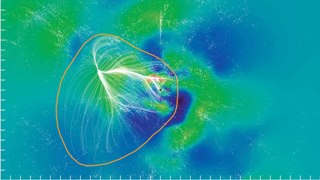Sep 4 2014
Astronomers using the National Science Foundation’s Green Bank Telescope (GBT) -- among other telescopes -- have determined that our own Milky Way galaxy is part of a newly identified ginormous supercluster of galaxies, which they have dubbed “Laniakea,” which means “immense heaven” in Hawaiian.
 A slice of the Laniakea Supercluster in the supergalactic equatorial plane -- an imaginary plane containing many of the most massive clusters in this structure. The colors represent density within this slice, with red for high densities and blue for voids -- areas with relatively little matter. Individual galaxies are shown as white dots. Velocity flow streams within the region gravitationally dominated by Laniakea are shown in white, while dark blue flow lines are away from the Laniakea local basin of attraction. The orange contour encloses the outer limits of these streams, a diameter of about 160 Mpc. This region contains the mass of about 100 million billion suns. Credit: SDvision interactive visualization software by DP at CEA/Saclay, France.
A slice of the Laniakea Supercluster in the supergalactic equatorial plane -- an imaginary plane containing many of the most massive clusters in this structure. The colors represent density within this slice, with red for high densities and blue for voids -- areas with relatively little matter. Individual galaxies are shown as white dots. Velocity flow streams within the region gravitationally dominated by Laniakea are shown in white, while dark blue flow lines are away from the Laniakea local basin of attraction. The orange contour encloses the outer limits of these streams, a diameter of about 160 Mpc. This region contains the mass of about 100 million billion suns. Credit: SDvision interactive visualization software by DP at CEA/Saclay, France.
This discovery clarifies the boundaries of our galactic neighborhood and establishes previously unrecognized linkages among various galaxy clusters in the local Universe.
“We have finally established the contours that define the supercluster of galaxies we can call home,” said lead researcher R. Brent Tully, an astronomer at the University of Hawaii at Manoa. “This is not unlike finding out for the first time that your hometown is actually part of much larger country that borders other nations.”
The paper explaining this work is the cover story of the September 4 issue of the journal Nature.
Superclusters are among the largest structures in the known Universe. They are made up of groups, like our own Local Group, that contain dozens of galaxies, and massive clusters that contain hundreds of galaxies, all interconnected in a web of filaments. Though these structures are interconnected, they have poorly defined boundaries.
To better refine cosmic mapmaking, the researchers are proposing a new way to evaluate these large-scale galaxy structures by examining their impact on the motions of galaxies. A galaxy between structures will be caught in a gravitational tug-of-war in which the balance of the gravitational forces from the surrounding large-scale structures determines the galaxy’s motion.
By using the GBT and other radio telescopes to map the velocities of galaxies throughout our local Universe, the team was able to define the region of space where each supercluster dominates. “Green Bank Telescope observations have played a significant role in the research leading to this new understanding of the limits and relationships among a number of superclusters,” said Tully.
The Milky Way resides in the outskirts of one such supercluster, whose extent has for the first time been carefully mapped using these new techniques. This so-called Laniakea Supercluster is 500 million light-years in diameter and contains the mass of one hundred million billion Suns spread across 100,000 galaxies.
This study also clarifies the role of the Great Attractor, a gravitational focal point in intergalactic space that influences the motion of our Local Group of galaxies and other galaxy clusters.
Within the boundaries of the Laniakea Supercluster, galaxy motions are directed inward, in the same way that water streams follow descending paths toward a valley. The Great Attractor region is a large flat bottom gravitational valley with a sphere of attraction that extends across the Laniakea Supercluster.
The name Laniakea was suggested by Nawa‘a Napoleon, an associate professor of Hawaiian Language and chair of the Department of Languages, Linguistics, and Literature at Kapiolani Community College, a part of the University of Hawaii system. The name honors Polynesian navigators who used knowledge of the heavens to voyage across the immensity of the Pacific Ocean.
The other authors are Hélène Courtois (University Claude Bernard Lyon 1, Lyon, France), Yehuda Hoffman (Racah Institute of Physics, Hebrew University, Jerusalem), and Daniel Pomarède (Institute of Research on Fundamental Laws of the Universe, CEA/Saclay, France).
The GBT is the world's largest fully steerable radio telescope. Its location in the National Radio Quiet Zone and the West Virginia Radio Astronomy Zone protects the incredibly sensitive telescope from unwanted radio interference.